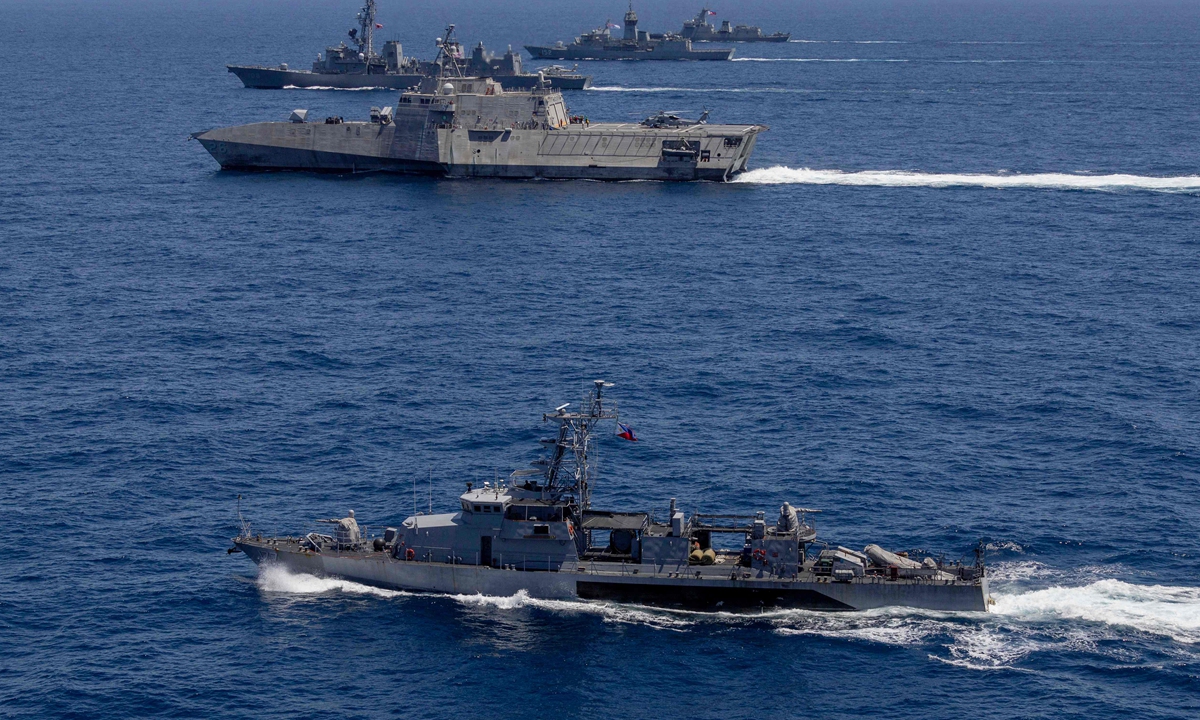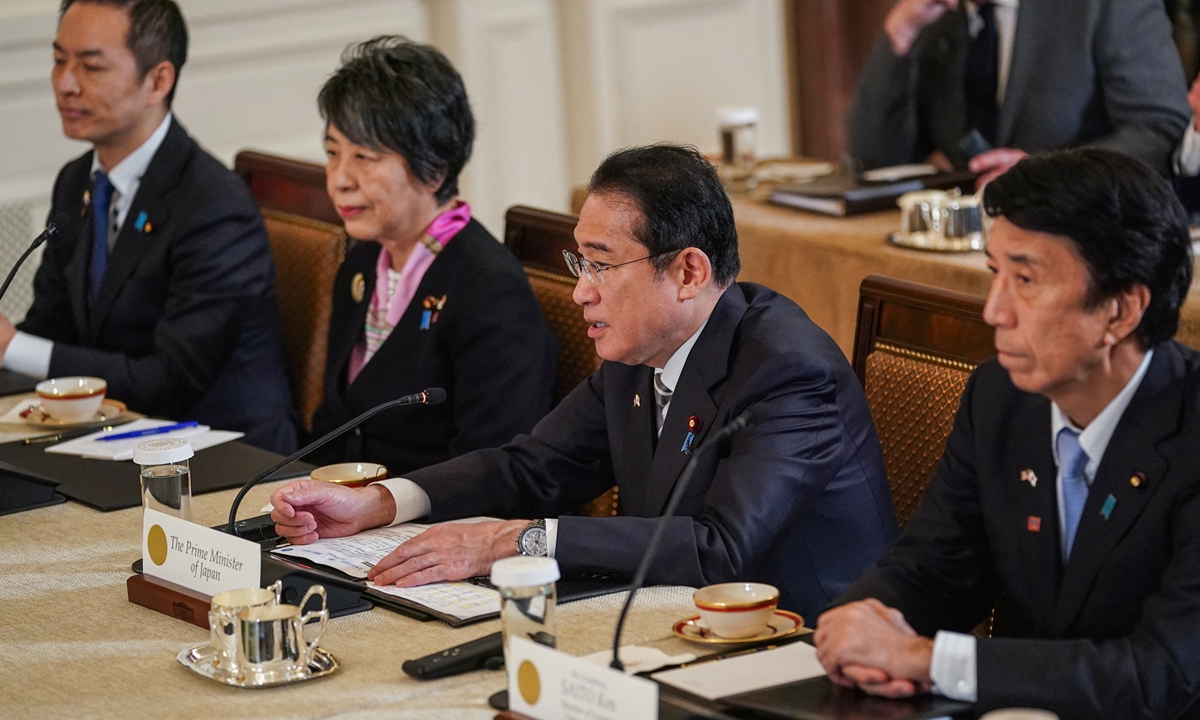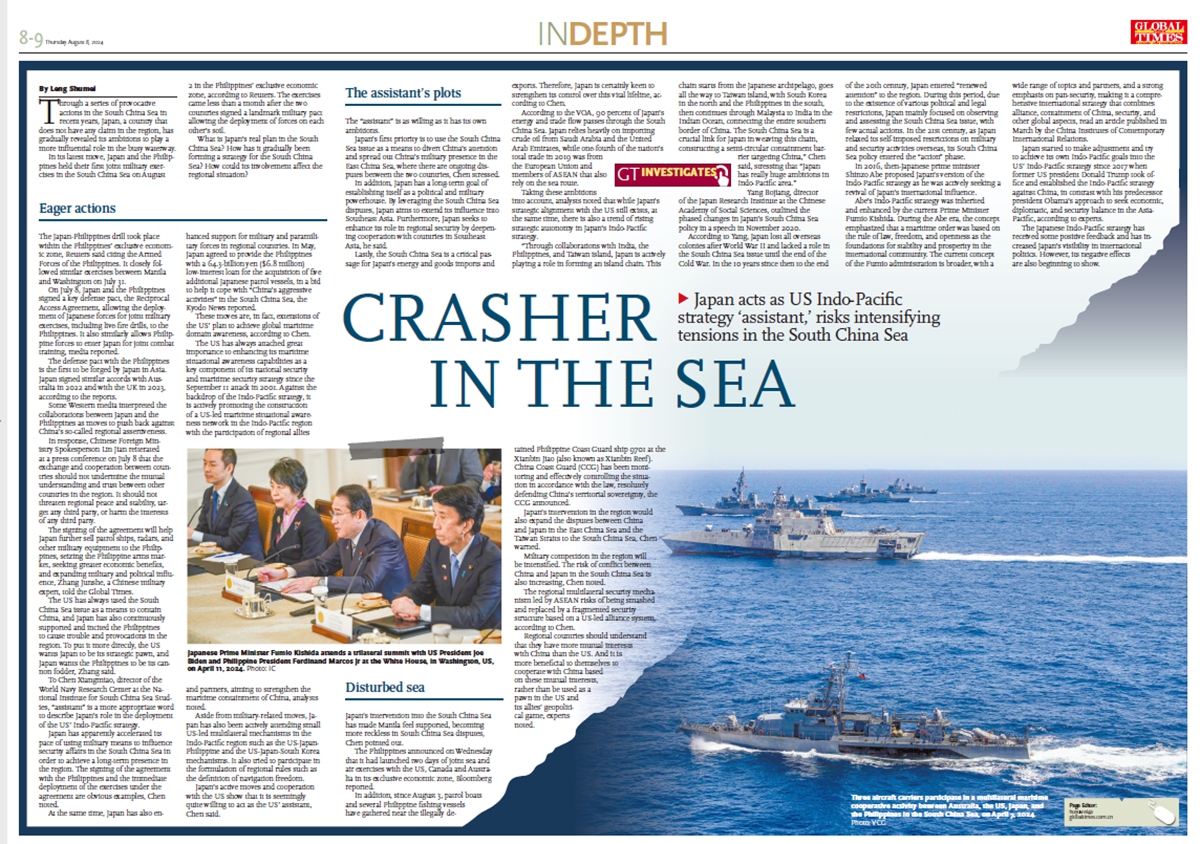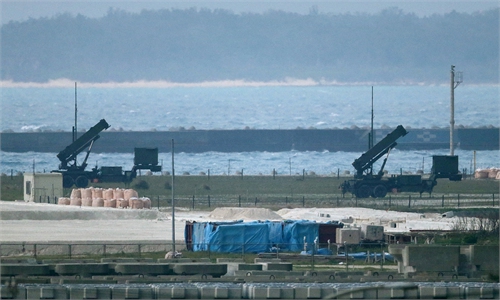IN-DEPTH / IN-DEPTH
GT investigates: Japan acts as US Indo-Pacific strategy ‘assistant,’ risks intensifying tensions in the South China Sea
Crasher in the sea

Three aircraft carriers participate in a multilateral maritime cooperative activity between Australia, the US, Japan, and the Philippines?in the South China Sea, on April 7, 2024. Photo: VCG
Through a series of provocative actions in the South China Sea in recent years, Japan, a country that does not have any claim in the region, has gradually revealed its ambitions to play a more influential role in the busy waterway.
In its latest move, Japan and the Philippines held their first joint military exercises in the South China Sea on August 2 in the Philippines' exclusive economic zone, according to Reuters. The exercises came less than a month after the two countries signed a landmark military pact allowing the deployment of forces on each other's soil.
What is Japan's real plan in the South China Sea? How has it gradually been forming a strategy for the South China Sea? How could its involvement affect the regional situation?
Eager actions
The Japan-Philippines drill took place within the Philippines' exclusive economic zone, Reuters said citing the Armed Forces of the Philippines. It closely followed similar exercises between Manila and Washington on July 31.
On July 8, Japan and the Philippines signed a key defense pact, the Reciprocal Access Agreement, allowing the deployment of Japanese forces for joint military exercises, including live-fire drills, to the Philippines. It also similarly allows Philippine forces to enter Japan for joint combat training, media reported.
The defense pact with the Philippines is the first to be forged by Japan in Asia. Japan signed similar accords with Australia in 2022 and with the UK in 2023, according to the reports.
Some Western media interpreted the collaborations between Japan and the Philippines as moves to push back against China's so-called regional assertiveness.
In response, Chinese Foreign Ministry Spokesperson Lin Jian reiterated at a press conference on July 8 that the exchange and cooperation between countries should not undermine the mutual understanding and trust between other countries in the region. It should not threaten regional peace and stability, target any third party, or harm the interests of any third party.
The signing of the agreement will help Japan further sell patrol ships, radars, and other military equipment to the Philippines, seizing the Philippine arms market, seeking greater economic benefits, and expanding military and political influence, Zhang Junshe, a Chinese military expert, told the Global Times.
The US has always used the South China Sea issue as a means to contain China, and Japan has also continuously supported and incited the Philippines to cause trouble and provocations in the region. To put it more directly, the US wants Japan to be its strategic pawn, and Japan wants the Philippines to be its cannon fodder, Zhang said.
To Chen Xiangmiao, director of the World Navy Research Center at the National Institute for South China Sea Studies, "assistant" is a more appropriate word to describe Japan's role in the deployment of the US' Indo-Pacific strategy.
Japan has apparently accelerated its pace of using military means to influence security affairs in the South China Sea in order to achieve a long-term presence in the region. The signing of the agreement with the Philippines and the immediate deployment of the exercises under the agreement are obvious examples, Chen noted.
At the same time, Japan has also enhanced support for military and paramilitary forces in regional countries. In May, Japan agreed to provide the Philippines with a 64.3-billion yen ($6.8 million) low-interest loan for the acquisition of five additional Japanese patrol vessels, in a bid to help it cope with "China's aggressive activities" in the South China Sea, the Kyodo News reported.
These moves are, in fact, extensions of the US' plan to achieve global maritime domain awareness, according to Chen.
The US has always attached great importance to enhancing its maritime situational awareness capabilities as a key component of its national security and maritime security strategy since the September 11 attack in 2001. Against the backdrop of the Indo-Pacific strategy, it is actively promoting the construction of a US-led maritime situational awareness network in the Indo-Pacific region with the participation of regional allies and partners, aiming to strengthen the maritime containment of China, analysts noted.
Aside from military-related moves, Japan has also been actively attending small US-led multilateral mechanisms in the Indo-Pacific region such as the US-Japan-Philippine and the US-Japan-South Korea mechanisms. It also tried to participate in the formulation of regional rules such as the definition of navigation freedom.
Japan's active moves and cooperation with the US show that it is seemingly quite willing to act as the US' assistant, Chen said.

Japanese Prime Minister Fumio Kishida attends a trilateral summit with US President Joe Biden and Philippine President Ferdinand Marcos Jr at the White House, in Washington, US, on April 11, 2024. Photo: IC
The assistant's plots
The "assistant" is as willing as it has its own ambitions.
Japan's first priority is to use the South China Sea issue as a means to divert China's attention and spread out China's military presence in the East China Sea, where there are ongoing disputes between the two countries, Chen stressed.
In addition, Japan has a long-term goal of establishing itself as a political and military powerhouse. By leveraging the South China Sea disputes, Japan aims to extend its influence into Southeast Asia. Furthermore, Japan seeks to enhance its role in regional security by deepening cooperation with countries in Southeast Asia, he said.
Lastly, the South China Sea is a critical passage for Japan's energy and goods imports and exports. Therefore, Japan is certainly keen to strengthen its control over this vital lifeline, according to Chen.
According to the VOA, 90 percent of Japan's energy and trade flow passes through the South China Sea. Japan relies heavily on importing crude oil from Saudi Arabia and the United Arab Emirates, while one-fourth of the nation's total trade in 2019 was from the European Union and members of ASEAN that also rely on the sea route.
Taking these ambitions into account, analysts noted that while Japan's strategic alignment with the US still exists, at the same time, there is also a trend of rising strategic autonomy in Japan's Indo-Pacific strategy.
"Through collaborations with India, the Philippines, and Taiwan island, Japan is actively playing a role in forming an island chain. This chain starts from the Japanese archipelago, goes all the way to Taiwan island, with South Korea in the north and the Philippines in the south, then continues through Malaysia to India in the Indian Ocean, connecting the entire southern border of China. The South China Sea is a crucial link for Japan in weaving this chain, constructing a semi-circular containment barrier targeting China," Chen said, stressing that "Japan has really huge ambitions in Indo-Pacific area."
Yang Bojiang, director of the Japan Research Institute at the Chinese Academy of Social Sciences, outlined the phased changes in Japan's South China Sea policy in a speech in November 2020.
According to Yang, Japan lost all overseas colonies after World War II and lacked a role in the South China Sea issue until the end of the Cold War. In the 10 years since then to the end of the 20th century, Japan entered "renewed attention" to the region. During this period, due to the existence of various political and legal restrictions, Japan mainly focused on observing and assessing the South China Sea issue, with few actual actions. In the 21st century, as Japan relaxed its self-imposed restrictions on military and security activities overseas, its South China Sea policy entered the "action" phase.
In 2016, then-Japanese prime minister Shinzo Abe proposed Japan's version of the Indo-Pacific strategy as he was actively seeking a revival of Japan's international influence.
Abe's Indo-Pacific strategy was inherited and enhanced by the current Prime Minister Fumio Kishida. During the Abe era, the concept emphasized that a maritime order was based on the rule of law, freedom, and openness as the foundations for stability and prosperity in the international community. The current concept of the Fumio administration is broader, with a wide range of topics and partners, and a strong emphasis on pan-security, making it a comprehensive international strategy that combines alliance, containment of China, security, and other global aspects, read an article published in March by the China Institutes of Contemporary International Relations.
Japan started to make adjustment and try to achieve its own Indo-Pacific goals into the US' Indo-Pacific strategy since 2017 when former US president Donald Trump took office and established the Indo-Pacific strategy against China, in contrast with his predecessor president Obama's approach to seek economic, diplomatic, and security balance in the Asia-Pacific, according to experts.
The Japanese Indo-Pacific strategy has received some positive feedback and has increased Japan's visibility in international politics. However, its negative effects are also beginning to show.
Disturbed sea
Japan's intervention into the South China Sea has made Manila feel supported, becoming more reckless in South China Sea disputes, Chen pointed out.
The Philippines announced on Wednesday that it had launched two days of joint sea and air exercises with the US, Canada and Australia in its exclusive economic zone, Bloomberg reported.
In addition, since August 3, patrol boats and several Philippine fishing vessels have gathered near the illegally detained Philippine Coast Guard ship 9701 at the Xianbin Jiao (also known as Xianbin Reef). China Coast Guard (CCG) has been monitoring and effectively controlling the situation in accordance with the law, resolutely defending China's territorial sovereignty, the CCG announced.
Japan's intervention in the region would also expand the disputes between China and Japan in the East China Sea and the Taiwan Straits to the South China Sea, Chen warned.
Military competition in the region will be intensified. The risk of conflict between China and Japan in the South China Sea is also increasing, Chen noted.
The regional multilateral security mechanism led by ASEAN risks of being smashed and replaced by a fragmented security structure based on a US-led alliance system, according to Chen.
Regional countries should understand that they have more mutual interests with China than the US. And it is more beneficial to themselves to cooperate with China based on these mutual interests, rather than be used as a pawn in the US and its allies' geopolitical game, experts noted.


